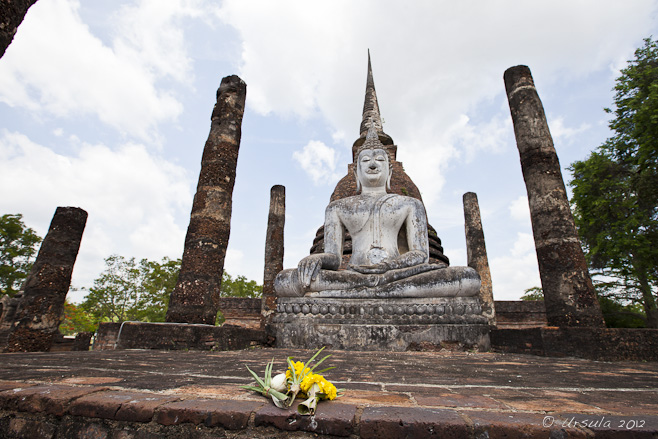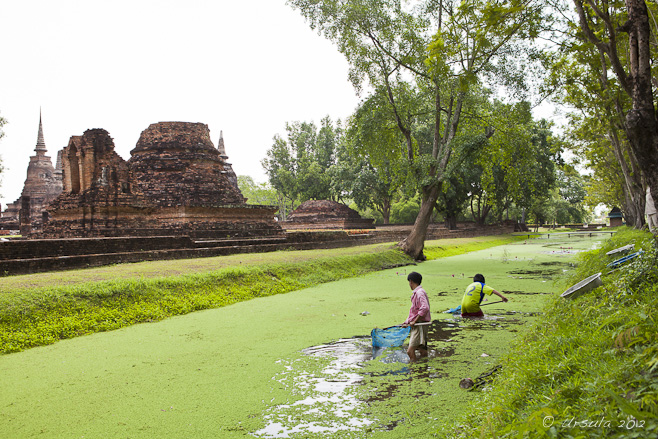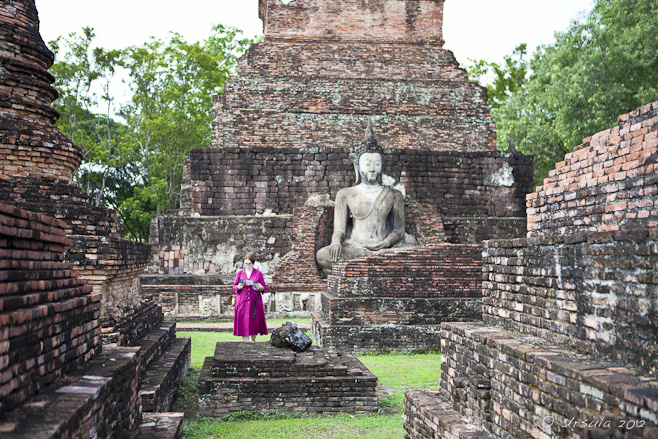
Offerings to ancient Buddhas
The beauty (and frustration) of living in Thailand lies in the ability of people to hold mutually incompatible ideas at the same time, and to never speak about some things which everyone knows.
Take Sukhothai, for example: that most revered of ancient Thai cities.
Sukhothai was originally a trade centre, enjoying a degree of autonomy under the various rule of the Mons of Lavo and the Khmer Empire, until becoming the centre of a kingdom in its own right in 1239. Even thought the kingdom only ruled for two hundred years, starting with the upper Chao Phraya valley, by some accounts, it eventually extended north into what is now Laos and south across much of the Isthmus of Kra. Traditional historians see this as the start of Thai history.
But, like everything else in Thailand, it is best not to try to examine concepts too closely. The Sukhothai legend has been invested with national importance and political ideology from the time King Mongkut read it into Thai history in the late nineteenth century. Since then, it has been used to defend the succession of kingdoms from father to son as a form of “Thai democracy”, and as a model of “freedom” from the colonial and Khmer rulers.
The most influential of the Sukhothai rulers, King Ramkhamhaeng, is credited with expanding the empire, inventing the Thai alphabet, and spreading Theravada Buddhism as the official religion. This influence is according to an engraved stone: the Ramkhamhaeng stele, reputedly discovered by King Mongkut in 1883. The authenticity of the inscriptions have been questioned, but if the doubts are proven, then much Thai history is thrown into question.
Whatever truths are buried in the legends, the ruins of the old empire are magnificent. Driving aroung the region, remains of red laterite brick wall, stupas and temples can be seen everywhere. Four separate sites are maintained, as UNESCO World Heritage Sites, under the unwieldly title of “Sukhothai and associated historic towns”.

Fishing for fish-food: in the moat around Wat Mahathat

Modern tourist ~ ancient ruins. Wat Mahathat, Sukhothai.

Some of the most evocative Buddha images at Wat Mahathat, to my mind, are those which have not been restored.

An imposing white buddha image in the Abhaya mudra – the hand gesture imparting fearlessness or reassurance.

Flowers at the feet of another standing buddha. Wat Mahathat.

Buddha in bhumisparsha mudra , or ‘touching the earth’ hand position.

Everything was rich and green, with lotus – symbols of purity and enlightenment – rising from the muddy moats.

A view of Sukhothai ruins through fresh green trees.

Workers, in long sleeves against the sun, work hard to keep the grounds nice. Of course, they don’t get paid much; I guess the honour is enough.

People bringing tributes and saying prayers to King Ramkhamhaeng the Great. For them, his “greatness” is not in question.

Thai Buddhists are not necessarily vegetarian; for some reason, many people were offering King Ramkhamhaeng pigs’ heads and feet.

Of course, King Ramkhamhaeng is also the recipient of flowers.
Karma, an integral part of Hinduism and Buddhism, is another one of those tricky words, and trickier concepts. In Thai, the word for Karma is “kaam” (กรรม), which, if not pronounced correctly becomes a vulgar epithet.
From the Sanskrit, karma can be defined as “the sum of a person’s actions in this and previous states of existence, deciding their fate in future existences”. In Thailand (and other countries in the region) it is not uncommon to see sparrows crowded into cages outside temples. The idea is that you purchase them and release them into freedom, thus buying good Karma for yourself. At Sukhothai, bags of fish and frogs were available for the same purpose.

Selling Karma: bags of fish and frogs for release back into the wild.

Captured spirits looking for release.
I find the idea that you can buy “good Karma” somewhat startling, and cannot help but wonder what capturing the birds, fish, and frogs does to the Karma of the collectors!

Wooden bridge leading to Wat Sa Si, Sukhothai

Looking through the rough, red laterite at a delicate white buddha. Wat Sa Si.

Flanked by pillars: Buddha, Wat Sa Si, Sukhothai.

Buddha in Vitarka mudra, symbolising intellectual argument and discussion. Wat Traphang Ngoen, Sukhothai.

Back robe detailing: Wat Traphang Ngoen

Buddha Remains ~ Wat Traphang Ngoen

After a morning of clambering around ruins, we arrived back at Wat Mahathat…

… ready for a hot, sweet, stimulant coffee after all that calm.
 Beautiful Buddhas, Karma and a Sukhothai king ~
Beautiful Buddhas, Karma and a Sukhothai king ~
And coffee.
Never mind the inconsistencies; you can’t ask much more than that!




























.png)


Nice set of photos Ursula. Regarding the collection of birds fish and frogs…… I guess that the person collecting them would gain good Karma too. After all, by their actions in collecting them, they are giving others the opportunity to make tamboon by setting them free!
Thanks Guava!
I do love the Thai’s ability to create jobs and I suppose you are right about the Karma on both sides of the frog exchange, but I couldn’t help but feel bad for the frogs. 🙁
I’ve been told that the sparrows in Phnom Penh return to their cages voluntarily after paid release, but the whole thing still sits uncomfortably with me.
great stuff as always … sorry i’m a little late this time.
Always glad to see you, Signe! 🙂
Have you changed your “identity”? The system didn’t recognise you and your avatar has disappeared.